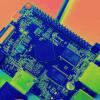
PoV
Members-
Posts
14 -
Joined
-
Last visited
Recent Profile Visitors
2188 profile views
-
Well I'm sold. Really hoping for Armbian support on these. Finally something at the "high end" you can plug in to a breadboard.
-
Hey! I just wanted to say thanks to martinayotte for patiently helping out. I was able to easily get the script here working on an Orange Pi One running a mainline Armbian: https://forum.armbian.com/index.php?/topic/3084-orange-pi-zero-python-gpio-library/&do=findComment&comment=28706 I used this version of the library. https://github.com/duxingkei33/orangepi_PC_gpio_pyH3 Installed it by following the instructions on that page. I already had GCC and `build-essentials` installed, but I did have to install the `python-dev` package before it would build though. I was then able to modify the sample script to toggle PA12 high and low (just like the LED) to make a Piezo buzzer do its thing. Used the pinout here as reference. http://linux-sunxi.org/Xunlong_Orange_Pi_One_%26_Lite I just wanted to collect my notes all in one place. Thanks again.
-
Hi. Sorry for the bump, but my Orange Pi PC+ just arrived, and I would like to put Xenial (Ubuntu) on it like the rest of my Orange Pi's. All (but one of) the H3 Xenial builds are missing from the download page. My apologies if there was a problem mentioned in another thread, but I couldn't find it after my quick search. Thanks.
-
Hey. I'm not sure if I perhaps caught the Armbian website in the middle of an update, but there doesn't seem to be any Ubuntu (Xenial) builds for H3 boards anymore ... with the exception of the NanoPi Neo. It's all Legacy Jessie builds right now. Thanks,
-

Tutorial Configuring Orange PI PC to receive IR/InfraRed
PoV replied to AnonymousPi's topic in Reviews, Tutorials, Hardware hacks
I like your style kid. -
Thanks for the clarification.
-
Hey actually I noticed something unusual in the H5 specs list. For one, the H5 makes mention SDIO 3.0 interfaces. Does this mean we'll finally getting better SD card performance? My Googling of the 3.0 spec seems to say so (50-104 MB cap, instead of ~25 MB), but I don't want to let myself get too excited. Secondly, it says it has three of them!? Now, this could be an error. The other diagram explicitly doesn't mention multiple SD interfaces, but damn, I want the SBC with 3 SD card slots you can plug high speed cards in to, and make them in to a RAID array. Do SDIO to SATA adapters exist?
-
I'm sorry, I just so amused by the fact that the 2nd board's chips are angled all crazy.
-
I just wanted to say thanks Helder Pereira. I was also finally able to get my headless Orange Pi Lite working thanks to this thread. A couple things to add: - I started with a bad memory card. The Orange Pi Lite has no LED indicators, until the OS starts booting properly. Ouch. - I spent waaay too long getting bad password, bad connection errors from wpa_supplicant. Turns out I was accidentially running another copy in the background, thanks to some other instructions (i.e. -B backgrounds it). I had to killall -q wpa_supplicant - I hide my SSID, which means HEADACHE when it comes to Linux networking. The trick to get that working is to add a single line "scan_ssid=1" inside the network block of wpa_supplicant.conf - "-D nl80211" seems to be optional on the latest version of Armbian. - I found this a good reference for making it auto-start with networking: http://askubuntu.com/a/406167
-
Cool cool. I've just ordered a Plus 2E (and a $12 Plus). I'd still prefer they'd make it 4 USB ports, instead of adding the OTG port. I'm not sure what WiFi adds to cost ($2?), but I wish they could make some tweaks and bump it even more; Either with even more eMMC, or down to $30 instead of $35.
-

Review Quick review of Orange Pi PC
PoV replied to tkaiser's topic in Reviews, Tutorials, Hardware hacks
Oh! So do you have a bench-top power supply, or did you hack-up a DC power adapter and attach pin headers? I'll admit, I might have spent a few too many days researching power and bench-top power supplies. It never occurred to me to power one of these micro computers with one. Do you mean that it messes with the output (I have noticed this, where I have to detach+reattach the USB cable for it to work properly), or do you mean by there being extra power it can't reboot? * * * On a related note, here's a weird piece of news: Olimex made their own "Orange Pi One" sized board. It has virtually all the same specs, but the GPIO is on the bottom (no headers/connector attached). https://www.olimex.com/ -

Review Quick review of Orange Pi PC
PoV replied to tkaiser's topic in Reviews, Tutorials, Hardware hacks
Yes, I'm asking if adding the other 2 pins would have worked (TXD and RXD in addition to VCC and GND). I've never tried powering a device using the "red wire" (I've only left VCC disconnected). I just want to make sure I grasp what's going on here. I realize the answer is probably yes (assuming that is a USB TTL cable). I'm just really impressed at how versatile these cables are. Nearly everything I've worked with in the past all had proprietary cables, so I never had to think about this. -

Review Quick review of Orange Pi PC
PoV replied to tkaiser's topic in Reviews, Tutorials, Hardware hacks
Hey, sorry a bit of a noob'ish question about powering the device(s). I noticed in the photo above that you bypassed the power connected and power the device via expansion pins. Is this via a USB TTL cable? If so, could you have connected the TX and RX pins for a serial connection? Thanks. -

Review Quick review of Orange Pi PC
PoV replied to tkaiser's topic in Reviews, Tutorials, Hardware hacks
That sounds amazing. All 4 of those independent USB ports (no OTG), Gigabit Ethernet, 2 GB RAM, for around $20. Would be the perfect brain for so many projects, instead of the half arsed boards we seem to have instead. I'm still fairly new to all this, but I've noticed testing the boards I have, I've been hitting a 10-20 MB upper limit on MicroSD card performance on pretty-much everything (despite using fast memory cards). Is there anything that can be done here, or is the I/O of the SD cards something the fault of the bargain chip(s) themselves?


